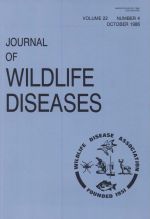Rectal temperatures and heart rates of American river otters (Lutra canadensis) decreased significantly (P < 0.05) during chemical immobilization with i.m. ketamine hydrochloride in combination with xylazine hydrochloride and acepromazine and during inhalation anesthesia with isoflurane. Anesthetized otters showed a tendency for apnea during induction and while dorsally recumbent, which was reflected by a respiratory acidosis on arterial blood gases. Declines in rectal temperatures and heart rates were not found to be a function of dosage (mg/kg) of the ketamine combination used except for rectal temperatures of otters in relatively poor body condition (inanition). The electrocardiograms of isoflurane-anesthetized otters were similar to those recorded on immobilized otters with the exception of an r′ deflection in the ventricular depolarization complex (RSr′). Electrocardiographic criteria were not found which predicted the degree of right ventricular or generalized cardiac enlargement seen radiographically.
How to translate text using browser tools
1 October 1986
PHYSIOLOGIC AND ELECTROCARDIOGRAPHIC RESPONSES OF AMERICAN RIVER OTTERS (LUTRA CANADENSIS) DURING CHEMICAL IMMOBILIZATION AND INHALATION ANESTHESIA
John P. Hoover,
Eugene M. Jones





